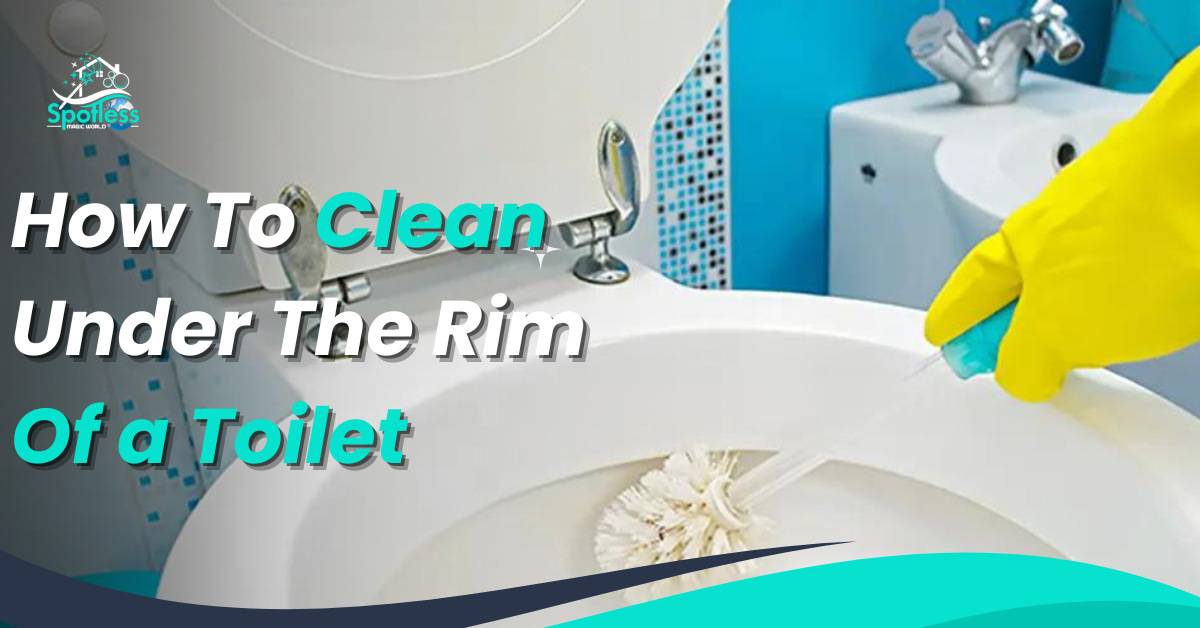Licensed And Insured

How To Clean Under The Rim of a Toilet
Let’s talk about a task that might not be the highlight of your day but is crucial for a sparkling clean home – cleaning under the rim of your toilet. Now, before you cringe and scroll past, hear me out! We’re diving into the nitty-gritty of toilet hygiene, but fear not because you’ll be armed with the know-how to tackle this chore like a pro by the end.
The Role of the Rim Jets
Rim jets are small holes located under the rim of your toilet bowl. They might not catch your eye, but they’re really important for keeping your toilet working well.
When you flush, they help water move from the tank to the bowl, ensuring everything gets washed away properly.
Their placement and shape help water swirl around, cleaning the inside of the bowl.
Additionally, they stop water from sitting still and germs from growing, which helps prevent bad smells and keeps your toilet clean and hygienic.
Therefore, cleaning under the rim of a toilet is very important.
Symptoms of Clogged Jets: Recognizing the Signs
Rim jets are crucial in ensuring efficient flushing and maintaining toilet hygiene. However, when these tiny openings become obstructed, they can wreak havoc on your toilet’s performance, leading to undesirable symptoms. Let’s delve into the signs that indicate your toilet’s jets may be clogged:
- Weak Flushes: A weak or insufficient flush is one of the most noticeable symptoms of clogged jets. When the rim jets are obstructed, water flow into the bowl becomes restricted, resulting in a feeble flush that fails to effectively remove waste and debris.
- Slow Draining: Clogged jets can cause water to drain slowly from the toilet bowl after flushing. This sluggish drainage occurs due to inadequate water pressure due to the obstruction, leading to lingering water and potential waste buildup in the bowl.
- Incomplete Flushing: Have you ever experienced the frustration of flushing your toilet only to find that not all waste has been removed? This symptom often indicates clogged jets, as the insufficient water flow fails to thoroughly rinse the bowl, leaving remnants of waste.
- Gurgling Noises: Another subtle yet indicative symptom of clogged jets is the presence of gurgling noises during or after flushing. These sounds occur as water attempts to pass through the obstructed jets, resulting in air bubbles and turbulent flow within the plumbing system.
- Visible Debris or Buildup: Take a closer look under the rim of your toilet bowl. Do you notice any visible debris, mineral deposits, or discoloration around the rim jets? These signs suggest a buildup of material within the jets, obstructing water flow and impeding their ability to function properly.
- Foul Odors: A less obvious but equally unpleasant symptom of clogged jets is the presence of foul odors emanating from the toilet bowl. When waste remains trapped due to inadequate flushing, it can decompose and produce unpleasant smells, signaling a potential issue with the toilet’s flushing mechanism.
Inspecting the Jets
You can simply inspect the condition of your toilet jet with just a mirror. Hold the mirror underneath the toilet bowl’s rim and closely examine the jet holes.
If you notice dark orange or black spots around the area, it shows bacterial buildup.
Again, the culprit is mineral buildup if you observe scaly, light-colored deposits.
In some cases, you may encounter both issues concurrently, requiring thorough cleaning and maintenance to restore optimal functionality. If you notice these problems, then it’s time to clean under the rim of your toilet.
How to clean under the rim of a toilet
Keeping the rim holes clean is essential to maintain toilet hygiene. Here is a step-by-step guide on how to clean under the rim of a toilet.
1. Mix Bleach and Water:
Start by preparing a bleach solution for cleaning. Mix one part bleach with ten parts water in a bucket or container. Bleach is a powerful disinfectant that effectively kills bacteria and removes stains, making it ideal for cleaning under the rim of a toilet.
2. Pour Solution in Overflow Tube:
Once you’ve prepared the bleach solution, carefully pour it into the overflow tube inside the toilet tank. The overflow tube is usually a small, vertical pipe connected to the toilet’s fill valve. This allows the bleach solution to flow into the toilet bowl and do the toilet bowl rim cleaning. It reaches the places where bacteria and mineral deposits may be present.
3. Let the Cleaning Solution Sit:
Allow the bleach solution to sit in the overflow tube and flow into the toilet bowl for several minutes. This dwell time allows the bleach to disinfect the toilet bowl and break down any buildup or stains under the rim and around the jet holes.
4. Clear Out the Jet Holes:
After the bleach solution has worked magic, it’s time to clear the jet holes. Use a small brush or tool, such as a wire or old toothbrush, to gently scrub the rim jets and remove any remaining debris or buildup. Cleaning toilet bowl edges helps you remove the bacteria. Be thorough but cautious to avoid damaging the porcelain or the jets themselves.
5. Clean with Bowl Cleaner:
Following scrubbing the jet holes, apply a toilet bowl cleaner specifically designed to target stains and bacteria. Use a toilet brush to scrub the entire bowl, including under the rim, ensuring thorough cleaning and disinfection. Combining bleach solution and bowl cleaner removes stubborn stains and eliminates bacteria, leaving your toilet sparkling clean.
6. Add Bleach Solution:
As a final step, add a final dose of bleach solution directly into the toilet bowl. This additional application helps maintain cleanliness and disinfection, ensuring the toilet remains fresh and odor-free until the next cleaning cycle.
By following these detailed under-rim toilet cleaning techniques and utilizing bleach solution effectively, you can effectively clean under the rim of your toilet, removing bacteria and mineral deposits for a hygienic and pristine bathroom environment. Remember to wear gloves and ensure adequate ventilation when working with bleach to protect yourself from potential irritants.
How to Clean Out Mineral Deposits
The process of cleaning out mineral deposits is similar to cleaning out bacteria. But there is a slight difference. Instead of bleach mix, we need to use vinegar for this process. The steps are-
- Warm up vinegar at 120 degrees Fahrenheit with water in a bucket container.
- Pour the solution on the affected areas and let it sit for 30 minutes. This will allow the solution to dissolve the deposits.
- Scrub the areas with visible mineral deposits with a toilet brush. Follow the toilet rim scrubbing methods.
- Flush the toilet to rinse away the loosened mineral deposits and vinegar solution.
- Use a water softener or install a toilet tank tab to prevent future mineral buildup.
Wrapping Up
Maintaining a clean and hygienic toilet is essential for a healthy home environment. Cleaning under the rim of the toilet and addressing any clogged jets or mineral deposits ensures optimal flushing performance and prevents unpleasant odors and hygiene issues.
By following the step-by-step cleaning techniques outlined above, using bleach or vinegar solutions effectively, and incorporating regular maintenance into your cleaning routine, you can achieve a sparkling clean toilet that is both functional and bacteria-free.
If you find any further problems, the spotless magic world is always at your service. With our skilled cleaning experts, we provide the best house cleaning service in Greenville. Contact us now for a seamless cleaning experience.



